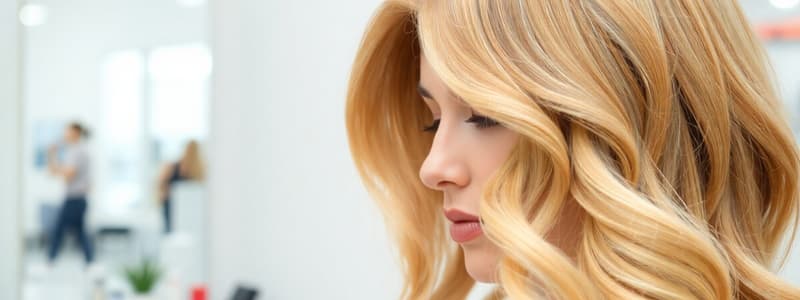Podcast
Questions and Answers
What are the two types of melanin responsible for hair color?
What are the two types of melanin responsible for hair color?
Eumelanin and pheomelanin.
List the three aims of hair coloring.
List the three aims of hair coloring.
To cover grey hair, to change existing color, and to combine both aims.
What is the main oxidizing agent used in hair bleaching?
What is the main oxidizing agent used in hair bleaching?
Hydrogen peroxide (H2O2).
Why should hair not be washed prior to bleaching?
Why should hair not be washed prior to bleaching?
What role does ammonium hydroxide play in the bleaching process?
What role does ammonium hydroxide play in the bleaching process?
How does the temperature of the scalp affect the bleaching process?
How does the temperature of the scalp affect the bleaching process?
What is the purpose of using acidic shampoos after bleaching?
What is the purpose of using acidic shampoos after bleaching?
What is a common material used alongside hydrogen peroxide in modern bleaching products?
What is a common material used alongside hydrogen peroxide in modern bleaching products?
What percentage of disulfide bonds are broken during the hair perm reducing step?
What percentage of disulfide bonds are broken during the hair perm reducing step?
What is the most common reducing agent used in hair perming?
What is the most common reducing agent used in hair perming?
What role does H2O2 play in the hair perming process?
What role does H2O2 play in the hair perming process?
How long is the process time for applying thioglycolic acid during perming?
How long is the process time for applying thioglycolic acid during perming?
Explain the purpose of the neutralization stage in hair perming.
Explain the purpose of the neutralization stage in hair perming.
What is the aim of hair straightening or relaxing?
What is the aim of hair straightening or relaxing?
How often does regrowth require a new treatment during hair straightening?
How often does regrowth require a new treatment during hair straightening?
What is one key difference between hair perming and hair relaxing?
What is one key difference between hair perming and hair relaxing?
What is the primary chemical used in permanent hair colorants to oxidize dye precursors?
What is the primary chemical used in permanent hair colorants to oxidize dye precursors?
What is the pH range for demi-permanent and tone-on-tone hair colorants?
What is the pH range for demi-permanent and tone-on-tone hair colorants?
How do semi-permanent hair colorants achieve penetration into the hair?
How do semi-permanent hair colorants achieve penetration into the hair?
What distinguishes temporary hair colorants from other types?
What distinguishes temporary hair colorants from other types?
What is the effect of using lead acetate in progressive hair colorants?
What is the effect of using lead acetate in progressive hair colorants?
What type of alkaliser is used in demi-permanent hair colorants?
What type of alkaliser is used in demi-permanent hair colorants?
In what year was p-phenylenediamine discovered, marking the birth of the synthetic hair dye industry?
In what year was p-phenylenediamine discovered, marking the birth of the synthetic hair dye industry?
Why is there a need for a positive dye list in the EU?
Why is there a need for a positive dye list in the EU?
What is the primary characteristic of temporary hair dyes regarding their duration on the hair?
What is the primary characteristic of temporary hair dyes regarding their duration on the hair?
How do cationic dyes interact with hair compared to anionic dyes?
How do cationic dyes interact with hair compared to anionic dyes?
Why are large cationic molecules used in rinse-off products for hair coloring?
Why are large cationic molecules used in rinse-off products for hair coloring?
What compounds are primarily involved in the reducing stage of hair perming?
What compounds are primarily involved in the reducing stage of hair perming?
How does the oxidation stage in hair perming utilize hydrogen peroxide?
How does the oxidation stage in hair perming utilize hydrogen peroxide?
What effect does bleaching have on the perming process?
What effect does bleaching have on the perming process?
What is the significance of the low viscosity formulation for perming agents?
What is the significance of the low viscosity formulation for perming agents?
What is the primary role of hydrogen peroxide in hair dyeing?
What is the primary role of hydrogen peroxide in hair dyeing?
How do high pH levels affect the hair during the dyeing process?
How do high pH levels affect the hair during the dyeing process?
What internal stress do hair fibres undergo during the perming process?
What internal stress do hair fibres undergo during the perming process?
What undesirable effects does bleaching have on the hair?
What undesirable effects does bleaching have on the hair?
What characterizes demi and semi-permanent hair dyes?
What characterizes demi and semi-permanent hair dyes?
Why are color pairs used in hair dye formulations?
Why are color pairs used in hair dye formulations?
What is a key secondary product formed during the bleaching process?
What is a key secondary product formed during the bleaching process?
How does the increase in hair hydrophilicity affect dye penetration?
How does the increase in hair hydrophilicity affect dye penetration?
What happens to the peptide bonds during the bleaching process?
What happens to the peptide bonds during the bleaching process?
What is the role of alkali in hair relaxing treatments?
What is the role of alkali in hair relaxing treatments?
What happens to S-S bonds during the hair relaxing process?
What happens to S-S bonds during the hair relaxing process?
Why is protective cream applied to the scalp during hair relaxing?
Why is protective cream applied to the scalp during hair relaxing?
What is the main concern regarding the effectiveness of Guanidine Hydroxide in hair relaxing?
What is the main concern regarding the effectiveness of Guanidine Hydroxide in hair relaxing?
Describe the significance of thorough rinsing after applying the alkaline cream.
Describe the significance of thorough rinsing after applying the alkaline cream.
What are 'lye relaxers' and how do they differ from non-lye relaxers?
What are 'lye relaxers' and how do they differ from non-lye relaxers?
What are the anticipated effects of hair relaxing treatments on hair's physical properties?
What are the anticipated effects of hair relaxing treatments on hair's physical properties?
What trend is influencing the current market for hair treatments?
What trend is influencing the current market for hair treatments?
Flashcards
Hair Coloring
Hair Coloring
The process of changing the color of hair using chemical products.
Eumelanin and Pheomelanin
Eumelanin and Pheomelanin
Pigments naturally present in hair, responsible for its color.
Hair Bleaching
Hair Bleaching
The process of lightening the natural hair color using chemicals.
Alkaliser (Ammonium Hydroxide)
Alkaliser (Ammonium Hydroxide)
Signup and view all the flashcards
Oxidising Agent (H2O2)
Oxidising Agent (H2O2)
Signup and view all the flashcards
Chelating Agents
Chelating Agents
Signup and view all the flashcards
Persulfates
Persulfates
Signup and view all the flashcards
Thickening/Creams and Root Application
Thickening/Creams and Root Application
Signup and view all the flashcards
Permanent Hair Dye
Permanent Hair Dye
Signup and view all the flashcards
Oxidative Hair Dye
Oxidative Hair Dye
Signup and view all the flashcards
Demi-Permanent Hair Dye
Demi-Permanent Hair Dye
Signup and view all the flashcards
Semi-Permanent Hair Dye
Semi-Permanent Hair Dye
Signup and view all the flashcards
Temporary Hair Dye
Temporary Hair Dye
Signup and view all the flashcards
Progressive Hair Color
Progressive Hair Color
Signup and view all the flashcards
Hydrogen Peroxide (H2O2)
Hydrogen Peroxide (H2O2)
Signup and view all the flashcards
Ammonia
Ammonia
Signup and view all the flashcards
Dye precursors
Dye precursors
Signup and view all the flashcards
Direct dyes
Direct dyes
Signup and view all the flashcards
Keratin
Keratin
Signup and view all the flashcards
Oxidation of disulfide bonds
Oxidation of disulfide bonds
Signup and view all the flashcards
Cuticle
Cuticle
Signup and view all the flashcards
Cortex
Cortex
Signup and view all the flashcards
Bleaching
Bleaching
Signup and view all the flashcards
Hair perming
Hair perming
Signup and view all the flashcards
Reducing Agent (thioglycolic acid)
Reducing Agent (thioglycolic acid)
Signup and view all the flashcards
Hair Straightening (Relaxing)
Hair Straightening (Relaxing)
Signup and view all the flashcards
Hair Straightening of Mid Curly Hair
Hair Straightening of Mid Curly Hair
Signup and view all the flashcards
Regrowth Time (6 weeks)
Regrowth Time (6 weeks)
Signup and view all the flashcards
Disulfide Bond Rearrangement
Disulfide Bond Rearrangement
Signup and view all the flashcards
Hair Perming vs. Straightening
Hair Perming vs. Straightening
Signup and view all the flashcards
Cationic Temporary Hair Dyes
Cationic Temporary Hair Dyes
Signup and view all the flashcards
Anionic Temporary Hair Dyes
Anionic Temporary Hair Dyes
Signup and view all the flashcards
Reducing Stage in Hair Perming
Reducing Stage in Hair Perming
Signup and view all the flashcards
Oxidizing Stage in Hair Perming
Oxidizing Stage in Hair Perming
Signup and view all the flashcards
Disulfide Exchange in Hair Perming
Disulfide Exchange in Hair Perming
Signup and view all the flashcards
Internal Stress in Hair Perming
Internal Stress in Hair Perming
Signup and view all the flashcards
Hair Relaxing
Hair Relaxing
Signup and view all the flashcards
Alkaline Agents
Alkaline Agents
Signup and view all the flashcards
Texturisers
Texturisers
Signup and view all the flashcards
Lanthionine Formation
Lanthionine Formation
Signup and view all the flashcards
Loss of Hair Elasticity
Loss of Hair Elasticity
Signup and view all the flashcards
Scalp Protection
Scalp Protection
Signup and view all the flashcards
Neutralising Shampoo
Neutralising Shampoo
Signup and view all the flashcards
Minimally Aggressive Treatments
Minimally Aggressive Treatments
Signup and view all the flashcards
Study Notes
Specialist Haircare Products
- The presentation is about specialist haircare products, specifically focusing on hair colouring, perming, and relaxing.
- The presentation includes historical context, chemical processes, and practical application for hair treatments.
- Various techniques and considerations are explored for different hair types and desired outcomes.
Hairdressing History
- Images from the 1920s show hairdressing techniques at UAL.
- This indicates the presentation covers historical developments in hairstyling and possibly touches on the evolution of haircare products.
Lesson Agenda
- The agenda covers hair colouring.
- It includes hair perming and relaxing, highlighting key differences.
- It also covers an overview of hair fibre properties versus chemical alterations, showing how chemical treatments affect the hair structure.
Hair Colour
- Hair colour is due to eumelanin and pheomelanin deposited during hair growth.
- Hair greying is linked to cumulative oxidative damage, genetic factors, stress, and nutrition.
- Studies show temporary or partial reversion is possible.
Hair Colouring
- Hair colouring can aim to cover grey hair, change existing colour, or combine both.
- Longevity of colour results varies depending on the type of hair colour product.
- Common types and levels of lastingness for hair colour products are presented in a table.
Basics of Hair Bleaching
- Commonly used bleaching materials include hydrogen peroxide (H2O2) and alkalisers like ammonium hydroxide.
- Chemicals are mixed just before application to ensure effectiveness, and reduce irritation.
- Recommendations for using and mixing bleaching agents are detailed, including thickening and avoiding scalp issues.
Hair Colour Lightening
- Lightening is necessary for colouring.
- Most permanent colourants involve some level of oxidation.
- A table shows different levels of bleaching power associated with different hair colours.
Hair Colourants: Product Types and Modes of Action
- Permanent hair dyes are a two-component system mixing just before use.
- Alkaline (Ammonia) and Hydrogen Peroxide (H2O2) are used to oxidise dye precursors, resulting in large dye molecules trapped within hair.
- Demi-permanent or tone-on-tone dyes use a different alkaliser(monoethanolamine or Amino methyl propanol) and lower concentrations of H2O2 to colour the hair, penetration is not as great as with permanents.
- Semi-permanent dyes are intensely coloured molecules that penetrate the cortex of hair.
- Temporary hair dyes are intrinsically coloured molecules that reside on the surface of hair.
Hair Colouring Summary
- Hair dyeing can be dramatic or subtle.
- Phenylenediamine was discovered in 1883, which marked the beginning of synthetic hair dye industry.
- Currently, there is positive list of dyes and global scrutiny to ensure minimal dermatological and toxicological effects.
Oxidative Hair Dyes
- Oxidative hair dyes use two components which are mixed before application.
- Colourless dye precursor molecules penetrate the hair and are oxidised to form coloured polymeric dyes inside the hair.
- Primary intermediates and couplers form dye molecules, producing a variety of colours.
- These colours are typically wash-resistant and typically involve 2-5 primary intermediates and 2-5 couplers.
Chemistry of Permanent Hair Dyes
- Permanent hair dyes involve primary intermediates (often p-diamines or p-aminophenols).
- They are oxidised by hydrogen peroxide, creating reactive species that react with couplers to form dyes.
- Hydrogen peroxide, ammonia, and ethanolamine are also commonly used ingredients.
- Coupling agents (colour couplers) react with primary intermediates to form dyes.
Damage from Bleaching
- The primary goal of bleaching is oxidation of melanin, but the products of this reaction may not be characterised.
- Secondary effects (undesirable) are weakening of the hair.
- Oxidation of disulfide bonds to cysteine acid is listed as one of the effects.
Demi and Semi-Permanent Hair Dyes: Direct Dyes
- Direct dyes are intrinsically coloured molecules.
- No chemical reactions take place during application.
- These dyes provide intense vibrant colours, frequently used for mixing and matching various shades.
- Formulated at pH 8.5-9.5 along with MEA to temporarily increases swelling of hair and allows dye penetration to be longer-lasting.
- A cap may be used to increase effects of the dye.
Hair Fibre and the Dye Molecules
- Micrographs illustrate the penetration and distribution of dyes within hair fibres.
- Permanent dyes penetrate deeply into the hair cortex, visible in the micrograph images.
- Semipermanent dyes are distributed more superficially, showing in the micrograph images.
Temporary Hair Dyes
- Temporary hair dyes last one shampoo, and are high-intensity vibrant colours.
- They do not transfer to clothes through rubbing.
- Cationic dyes are highly attracted to the hair.
- They are often used for temporary colouring or boosting colours after oxidative colouring.
Some Temporary Hair Dyes
- Temporary hair dyes include large molecules that reside on hair surface and offer subtle colour effects.
- Substantivity of the dye molecules allows them to be used in rinse-off products.
- Types of temporary dyes mentioned are 'Basic' (cationic) and 'Acid' (anionic).
Hair Perming and Relaxing: Similarities and Differences
- Hair perming and relaxing use similar chemical concepts.
- Differences lie in their goals (change in shape vs. straightening).
- Both involve chemical alterations which affect properties of hair fibre.
Chemistry of Hair Perming (Cold Waving)
- Thioglycolic acid (TGA) and glycerol thioglycolate (GTG) are used in different pH to achieve loose or tighter waves.
- High pH is needed to swell the cuticle, allowing precursor molecules to penetrate.
- H2O2 (hydrogen peroxide) along with acid are used for oxidation to create more permanent curls.
Chemistry of Hair Perming
- Hair fibres under stress from being wound onto rollers affect -S-S bonds.
- This leads to disulfide bonds rearranging in a process called disulfide exchange.
- Thioglycolic acid is a common reducing agent, while H2O2 is a common oxidising agent.,
- 20% of disulfide bonds are broken to achieve new bonds.
Hair Perming Technique
- The hair is shampooed and towel-dried.
- Strands are applied to rollers under tension.
- The process and time are dependent on the specific hair type.
- Reducing agent is applied, followed by neutralisation.
Hair Lightening: Process, Hair Damage and Repair
- Hair lightening is a chemical process.
- Considerations should include the damage caused by lightening.
- Repair methods should be included.
Overview of Hair Fibre Properties vs Chemical Alterations
- Hair fibre properties are important to consider when using chemical alterations like lightening, perming, and relaxing.
- Chemical treatments alter the hair's structure.
Hair Straightening (Relaxing)
- Hair straightening is a permanent technique for changing hair shape.
- Hair that has been relaxed will need to be retreatment after about 6 weeks.
Oxidation of Disulfide Bonds
- At least 30-40% of the S-S bonds in the hair are affected when performing a straight hair style.
- A chemical reaction takes place to create a permanent bond, for instance the S-CH2 bond is created and called lanthionine.
- S-S bonds are not reformed, leading to loss of elasticity.
- The hair looses structure, as damage to the protein chains may occur and result in weakening of the hair.
Chemistry of Hair Relaxing
- Common alkaline agents (NaOH, KOH, LiOH) are used in thick emulsions for relaxing hair, and to avoid spreading to the scalp.
- Guanidine hydroxide is a milder alternative but less effective.
- The specific formulations may be referred to as "lye relaxers" but may also use alternative alkaline agents.
Hair Relaxing Technique
- Protective cream is applied to the scalp before the relaxing cream.
- Applying the relaxing cream to the hair strands should be done without stretching.
- Thorough rinsing both hair and scalp is required.
- A neutralising shampoo may be used to neutralize the alkaline reaction.
Summary of Chemical Treatments
- Fewer consumers are interested in altering hair colour and style.
- Less aggressive chemical treatments are developing in response.
Scenario 1, 2, 3
- Scenarios outlining specific hair conditions and desired outcomes to evaluate treatment options for changing hair style.
- These scenarios allow for evaluating the potential chemical treatments needed and predicting the potential damage from the procedure.
Studying That Suits You
Use AI to generate personalized quizzes and flashcards to suit your learning preferences.





